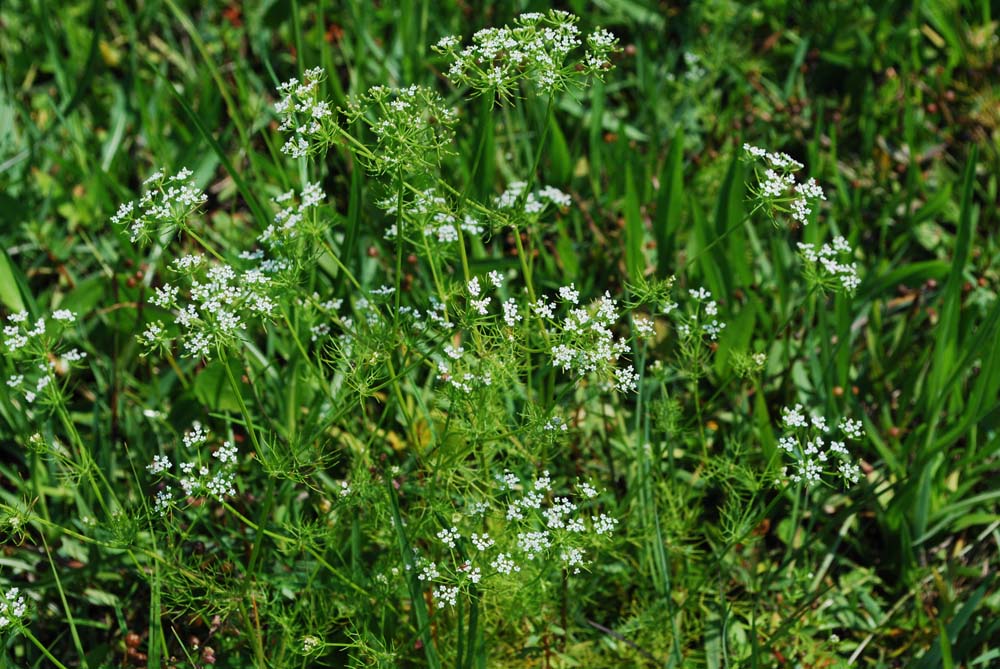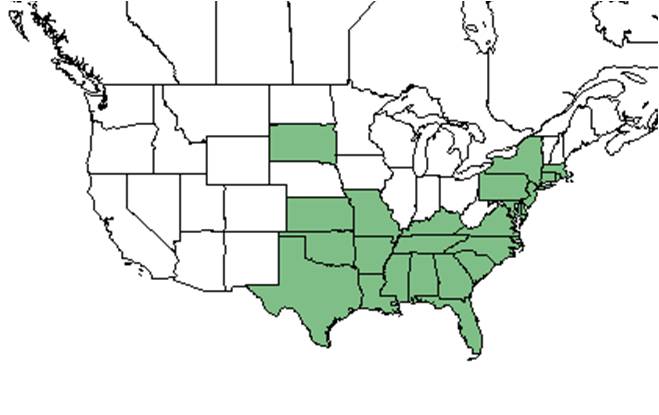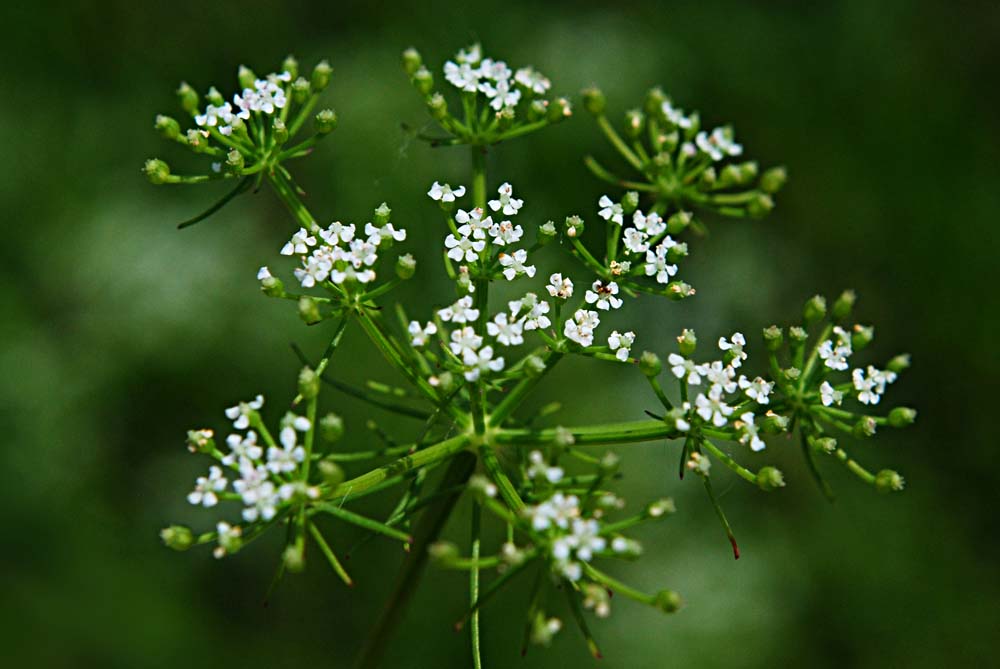Ptilimnium capillaceum
| Ptilimnium capillaceum | |
|---|---|

| |
| Photo by Wayne Matchett, SpaceCoastWildflowers.com | |
| Scientific classification | |
| Kingdom: | Plantae |
| Division: | Magnoliophyta - Flowering plants |
| Class: | Magnoliopsida – Dicotyledons |
| Order: | Apiales |
| Family: | Apiaceae |
| Genus: | Ptilimnium |
| Species: | P. capillaceum |
| Binomial name | |
| Ptilimnium capillaceum (Michx.) Raf. | |

| |
| Natural range of Ptilimnium capillaceum from USDA NRCS Plants Database. | |
Common names: Threadleaf mockbishopweed, herbwilliam
Contents
Taxonomic notes
Description
Flowers are arranged in umbels. [1]
"Glabrous annuals with pinnately decompound leaves or the leaves reduced to hollow, septate phyllodes. Umbels compound, terminal and axillary; involucre and involucel present; petals white. Fruit broadly ovoid to suborbicular, 1-4 mm long, glabrous, ribs prominent; mericarps semicircular in cross section." [2]
"Plant 1-8 dm tall. Leaves pinnately and finely decompound into numerous filiform segments 2-5 mm or more long. Peduncles 3-8 cm long; involucral bracts foliaceous, 5 mm or more long; rays 3-20, spreading, 6-21 mm long; involucel bractlets linear, about ½ length of pedicels; styles 0.2-1.5 mm long. Fruit 1.5-3 (4) mm long, 1.5 (2) mm broad." [2]
Distribution
It is distributed from eastern and central United States west to Texas and south to Miami-Dade and Collier counties[3].
Ecology
Habitat
In the Coastal Plain in Florida and Georgia, P. capillaceum has occurred in wiregrass/slashpine communities; the edge of a small cattail swale; mucky soils of floodplains; dry pond in a coastal hammock; cabbage palm hammocks; scrubby flatwoods adjacent to cypress swamps; slough edges; wet ditches bordering flatwoods; borders of salt flats; wet sands near a salt marsh; gum depressions; low depressions amongst sand dunes; middle of a lake growing on a tree stump; and cypress-sweetgum floodplains. It has also been observed in disturbed areas such as roadsides, a grazed cabbage palm hammock, moist roadside ditches, along railroad beds, marsh in a drainage canal bordering a swamp forest, permanently flooded pits, drained clearing of a wet hammock, exposed peat beneath pond cypresses ringing a lake after draining, and powerline transects across pine flatwoods. Soil types include loamy sand, sand, sandy loam, sandy peat, clay, and peaty soil. It has been observed to grow in both full sun and very shaded locations. Associated species include Anagallis minima, Eleocharis albida, Bacopa monnieri, Dichromena colorata and Sagittaria[4].
Phenology
It flowers and fruits April through July. [1]
Fire ecology
It has been observed in an annually burned boggy draw in a pine forest. [1]
Pollination
The following Hymenoptera families and species were observed visiting flowers of Ptilimnium capillaceum at Archbold Biological Station: Cite error: Closing </ref> missing for <ref> tag.
Conservation and management
Cultivation and restoration
Photo Gallery
Flowers of Ptilimnium capillaceum Photo by Wayne Matchett, SpaceCoastWildflowers.com
References and notes
- ↑ 1.0 1.1 1.2 Florida State University Robert K. Godfrey Herbarium database. URL: http://herbarium.bio.fsu.edu. Last accessed: November 2015. Collectors: William P. Adams, Loran C. Anderson, Kurt E. Blum, Dave Breil, Sidney T. Brinson, G. Fleming, P. Genelle,, C.S. Gidden, R.K. Godfrey, Darren Jackson, D.E. Kennemore Jr., G. Knight, Mabel Kral, R. Kral, Robert J. Lamaire, S.W. Leonard, Sidney McDaniel, William Lindsey,W. Miley, Marc Minno, Richard Mitchell, John B. Nelson, Elmer C. Prichard, Ronald A. Pursell, Gwynn W. Ramsey, P.L. Redfearn Jr., A. Redman, Grady W. Reinert, V. Rosario, Cecil R. Slaughter, Bian Tan, D.B. Ward, S.S. Ward, Jean W. Wooten. States and Counties: Florida: Alachua, Bradford, Brevard, Calhoun, Charlotte, Citrus, Columbia, DeSoto, Dixie, Escambia, Franklin, Hamilton, Hernando, Jackson, Jefferson, Lafayette, Leon, Liberty, Madison, Nassau, Okaloosa, Orange, Polk, Putnam, St. Johns, Sumter, Suwannee, Taylor, Union, Volusia, Wakulla. Georgia: Thomas. Compiled by Tall Timbers Research Station and Land Conservancy.
- ↑ 2.0 2.1 Radford, Albert E., Harry E. Ahles, and C. Ritchie Bell. Manual of the Vascular Flora of the Carolinas. 1964, 1968. The University of North Carolina Press. 784. Print.
- ↑ http://regionalconservation.org/beta/nfyn/plantdetail.asp?tx=Ptilcapi. Accessed: March 1, 2016
- ↑ Florida State University Robert K. Godfrey Herbarium database. URL: http://herbarium.bio.fsu.edu. Last accessed: November 2015. Collectors: William P. Adams, Loran C. Anderson, Kurt E. Blum, Dave Breil, Sidney T. Brinson, G. Fleming, P. Genelle,, C.S. Gidden, R.K. Godfrey, Darren Jackson, D.E. Kennemore Jr., G. Knight, Mabel Kral, R. Kral, Robert J. Lamaire, S.W. Leonard, Sidney McDaniel, William Lindsey,W. Miley, Marc Minno, Richard Mitchell, John B. Nelson, Elmer C. Prichard, Ronald A. Pursell, Gwynn W. Ramsey, P.L. Redfearn Jr., A. Redman, Grady W. Reinert, V. Rosario, Cecil R. Slaughter, Bian Tan, D.B. Ward, S.S. Ward, Jean W. Wooten. States and Counties: Florida: Alachua, Bradford, Brevard, Calhoun, Charlotte, Citrus, Columbia, DeSoto, Dixie, Escambia, Franklin, Hamilton, Hernando, Jackson, Jefferson, Lafayette, Leon, Liberty, Madison, Nassau, Okaloosa, Orange, Polk, Putnam, St. Johns, Sumter, Suwannee, Taylor, Union, Volusia, Wakulla. Georgia: Thomas. Compiled by Tall Timbers Research Station and Land Conservancy.
